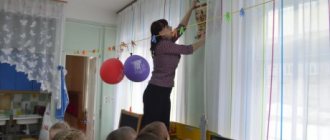Exercises for older preschool children
Rhetoric (exercises for the development of oral speech train the centers of the brain) has different levels of complexity. For children of senior preschool age, classes are held, the content of which corresponds to the amount of knowledge of each child.
Exercise “Story on a free topic”
To perform this collective exercise, it is enough for a group of children to be formed in the amount of 5 to 10 people. The average duration of a lesson is from 25 to 50 minutes. This is the period of time that will allow you to achieve maximum productivity in the educational process, as well as maintain a sufficient level of interest in children. Each child is given about 5 minutes to perform.
Goals and objectives
The main goal and objective of the exercise is to effectively form a culture of child’s speech behavior.
Equipment and materials
To conduct this lesson you will need the following equipment and materials:
- chairs to seat all group members, creating a target audience for the speaker;
- a clock with a timer to record the duration of each child’s performance;
- a chair and desk for the teacher, who sits away from the children;
- an improvised stage on which each child will appear during their performance.
After completing the preparatory activities, you can begin this exercise.
Methodology used
During this exercise, it is recommended to use a technique for assessing the progress of each child. To do this, you will need to prepare a checklist in advance, which will display the achievements of all students.
Introduction
At this stage, the teacher invites the children to take turns going on stage and performing an oral story on a given topic. The teacher focuses on the fact that the narration should be expressive, interesting, but at the same time as concise as possible, since each speaker has only 5 minutes.
Progress of the lesson
Completing the exercise “Story on a free topic” involves following the following algorithm of actions:
- The teacher invites the child onto an improvised stage in front of an audience of other children.
- Then the teacher asks the student to tell a story about a particular event. For example, a story on the topic: “How I visited my grandmother,” “Fishing trip with my father,” “My pet.” The topic for the story is chosen to be free and accessible to a child of the appropriate age.
- The child talks about a given topic for 5 minutes.
- After this, the teacher, together with the children, thanks the speaker, and then invites the next child to speak.
Children who are lost, embarrassed or have difficulty telling a story during a speech need to be encouraged and given confidence in their actions.
Knowledge control
At the end of the training, the teacher fills out a checklist in which he evaluates the speaking abilities of each child.
The following criteria are taken into account:
- clarity of speech;
- expressiveness;
- richness of vocabulary;
- content of the speech;
- brevity.
To carry out the assessment, a scale of 5 or 10 points is used. At the same time, the results of knowledge control are not disclosed to the children, but are used only by the teacher to further improve the rhetorical skills of each child.
The final stage
At the final stage of this lesson, the children thank each other for the interesting stories they heard during this exercise.
Exercise “Characteristics of an object”
Characterizing an object is an exercise that requires forming a group of 5 children. The average duration of a performance for 1 child is 10 minutes.
In total, the lesson lasts 50 minutes. working hours.
Goals and objectives
The purpose of this lesson is to form in the child the initial inclinations for oratory skills, to teach him the correct and consistent presentation of thoughts.
Equipment and materials
To conduct this lesson you will need to use the following materials:
- ball;
- Toothbrush;
- pencil;
- paper;
- plasticine.
All children of primary preschool age are familiar with these objects and can also describe their characteristics and purpose.
Methods used
During this lesson, methods are used in the form of assessing the child’s abilities using a checklist, and also use presentation techniques.
Introduction
At the preparatory stage, the teacher places the above items on the table in front of the children. After this, the teacher tells the children that they need to take turns standing up, coming forward and describing one of these things.
Progress of the lesson
An exercise to develop rhetorical abilities “Characteristics of the subject” is performed as follows:
- The teacher invites the child to an impromptu stage.
- The speaker receives one of the items described in the section above.
- According to the teacher’s instructions, the child spends 10 minutes. must tell the maximum amount of information about the thing given to him. The characteristics of the object and its intended purpose are fulfilled.
- After the specified period of time has passed, the child sits down, and the next group member is invited to perform.
During this lesson, the teacher can ask the child leading questions that simplify the storytelling process.
Knowledge control
Based on the results of the training, the teacher assigns grades to all participants in a checklist.
The final stage
At the final stage of the lesson, the teacher thanks the children for participating in the training, says that they tried very hard, and their stories were interesting.
Methods of speech development in preschool children
Rhetorical exercises for the development of oral speech in children involve the use of several pedagogical techniques, which are described in detail in the table below:
| Name of the technique | Description of the pedagogical process |
| Assessment of lesson results | Before starting training on the development of rhetorical skills, the teacher prepares special sheets for assessing knowledge. After the child completes a certain exercise, the teacher fills out an evaluation sheet, indicating the clarity and content of the student’s speech. This information is taken into account during subsequent sessions to monitor the child's level of progress. |
| Vocabulary expansion | Most of the difficulties in acquiring public speaking abilities are associated with poor vocabulary. In conjunction with performing classical exercises, it is necessary to use a dictionary. According to the teacher’s instructions, the child learns from 3 to 7 new words every day, depending on his intellectual abilities. |
| Retelling of the material presented | This technique allows you to learn the correct and consistent presentation of thoughts. First, the teacher reads a short passage of text, and then the children take turns telling in their own words what they heard. |
| Presentation | The rhetorical technique in the form of a presentation makes it possible to develop oratory skills and increase the child’s level of communication skills. The essence of this technique is that children take turns describing household items that were provided by the teacher. Each child tries to present the maximum amount of information about a given object. |
Methods for performing rhetorical exercises can be used in combination, or only one of the above-described techniques for developing oratorical abilities is used. At the same time, the number of people in the group, their age and level of intellectual development are taken into account.





